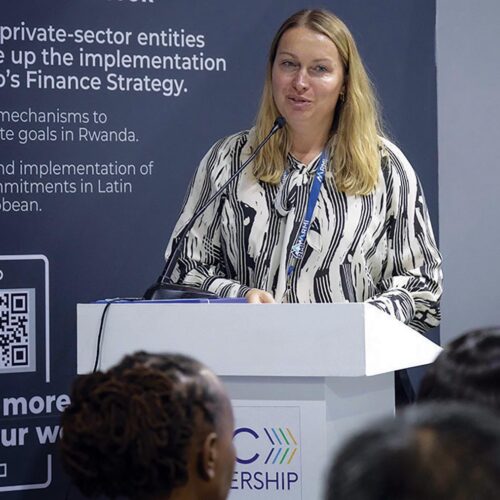Annual climate change conference COP 27 Sharm El-Sheikh in November 2022. International climate summit banner. Global Warming. Vector illustration

10 Key Takeaways from COP27
A huge step toward decarbonizing Indonesia, a small step forward on loss and damage, and one step back on fossil fuels.
COP27 is over but the work of implementing the decisions made in Sharm El-Sheikh (and at COPs before it) is already far underway. RMI attended COP27 with a focus on accelerating the energy transition particularly across the Global South, where clean energy is powering the creation of new jobs, new technology, and economic development, with our experts speaking at numerous events, making waves in the media, and announcing new initiatives. Once again, we saw the private sector turn out to demonstrate global progress, which gives more hope than what could be seen as a lack of political courage from national actors in the final COP27 text.
Here is a roundup of breakthroughs and big moments at COP27, from the lens of RMI’s focus on the clean energy transition.
1. A step forward on loss and damage, a step back on fossil fuels
The agreement hammered out after two weeks in the Egyptian resort town of Sharm El-Sheikh was short on details but was the first to include a fund for loss and damages. This fund will compensate countries that suffer from climate change but that have released little of the heat-trapping pollution responsible for it. While this is a first attempt to set aside resources for vulnerable countries, the consequences of past, present, and future combustion of fossil fuels will produce negative impacts on people and the planet for many years to come. This is why RMI was disappointed to see proposed language limiting the unabated combustion of oil and gas production stricken from the final agreement.
2. A re-commitment to the 1.5°C degree limit
RMI signed on with dozens of other business and NGOs to re-affirm its commitment to do everything in its power to get as close as possible to the 1.5°C limit set in place as part of the Paris Agreement and beyond which runaway global heating will occur. The G20 also voiced support for retaining 1.5°C, and UN negotiators said below 2°C. There were wavering voices in the political negotiation. RMI believes it is critical for all to remain focused on holding warming as close to 1.5°C as possible. Read the full statement assembled by our friends at the We Mean Business Coalition.
3. A $20B investment to move Indonesia to clean energy
The United States, Japan, Canada, and six European countries pledged to raise at least $20 billion under Indonesia’s Just Energy Transition Partnership (JETP) to help wean Indonesia off coal and reach carbon neutrality by 2050, a decade earlier than planned. Over the past 8 months, RMI has been supporting the Government of Indonesia to analyze its coal fleet and provide evidence-based guidance on the best path for Indonesia to transition to renewable energy through JETP engagements. This historic investment in clean energy for Indonesia is an important step toward building a model of cooperation that mobilizes capital while prioritizing communities. As one of the most coal-dependent countries on earth, Indonesia needs a plan that provides its citizens with a just and secure low-carbon pathway to prosperity.
4. Methane and super-polluters get more attention
At least 150 countries have now signed the Global Methane Pledge to cut methane emissions by 30 percent by 2030, 50 more countries than had signed the agreement at the time of last year’s COP. And although China didn’t sign, it developed a draft plan to curb its methane emissions. RMI and the Clean Air Task Force launched a new digital platform to connect satellite data with best practices to mitigate methane from waste, which produces almost 20 percent of global methane emissions.
Additionally, former US Vice President Al Gore announced his “secret weapon” for COP27 –– the release of Climate TRACE’s updated inventory of the world’s worst polluters, including facility-level emissions data for over 80,000 individual sources worldwide.
As the first global inventory to identify and track the largest individual sources of emissions across two dozen major sectors of the economy, Climate TRACE’s publicly available dataset illuminates the outsized role of a handful of individual sources on global emissions, particularly within the oil and gas sector. Among other findings, the new data revealed that 50 percent of the top 50 emitting sources globally are oil and gas fields. The Climate TRACE coalition is comprised of leading NGOs, technical experts, and climate scientists including RMI, WattTime, Earthrise Alliance, Blue Sky Analytics, Transition Zero, and Ocean Mind.
5. Climate finance access network expands further into Pacific, Caribbean
Early this year, RMI’s Climate Finance Access Network (CFAN) launched with a cohort of dedicated climate finance advisors in the Pacific, highly trained experts embedded in eight island nations working on advancing climate resilience and national adaptation goals. At COP27, funders announced new and extended support of CFAN’s model and mission. With the support of the government of Canada, the Open Society Foundations, and an anonymous philanthropic donor, CFAN will be extending the tenure of its existing Pacific Cohort, launching a second cohort in the Pacific to support four additional countries, and piloting advisory support in the Caribbean. With CFAN’s support, small island nations will be better positioned to unlock the finance needed to meet the challenges of climate change with resilience.
6. Expanding energy access in Africa with minigrids
At the same time, the UN Development Programme, RMI, and the African Development Bank promoted the new Africa Minigrids Program — a country-led technical assistance program to help African countries scale up and accelerate the deployment of renewable energy minigrids. “The Africa Minigrids Program is a clear demonstration of developing countries taking more control over their development destiny and addressing the need for access to electricity with a clean energy future,” Achim Steiner, administrator of the program, said at the launch.
7. Clean energy for the Caribbean
RMI and Lion’s Head Global Partners collaborated to launch a $150 million Caribbean Climate Smart Fund to invest in energy projects across the Caribbean. The fund has an initial target of $75 million, and includes a $15 million project preparation facility to accelerate the Caribbean’s energy transition. Although the region has seen an increase in climate finance and local interest in the prospect of transitioning to clean energy, more than 44 million people in the region still rely on fragile, fossil-based electricity systems. Projects under the new fund will support climate resilience in the face of intensifying storms. The projects will also stabilize electricity prices and increase energy security while avoiding many millions of dollars’ worth of fossil fuel imports each year.
8. Electric mobility for all
A recurring focus throughout COP27 was what the international community could do to increase accessible and scalable market-driven solutions to regions that are typically left to face the consequences of our climate crisis alone. In India, the transportation sector is the fastest growing source of emissions. To address this, RMI partnered with Indian governmental think tank NITI Aayog to revolutionize mobility through the Shoonya campaign. Shoonya — inspired by the Sanskrit word for zero — provides zero-emissions mobility access across India’s delivery and rideshare markets.
9. Decarbonizing global shipping
More transportation-focused solutions at COP emerged through the Joint Statement on Green Hydrogen and Green Shipping. Leading organizations across the various elements of the shipping value chain signed on to this commitment to accelerate the decarbonization of global shipping. The UN Climate Change High-Level Champions and RMI facilitated this momentous development toward widespread implementation of commercially viable zero-emissions vessels, green hydrogen for use in shipping, and the full decarbonization of global shipping by 2050.
10. Green job growth
Green jobs have the transformative properties needed to reach our urgent climate goals. They provide economic growth and self-determination for both nations and the people that live inside them. In addition to this, they contribute to a future free from fossil gas and the security issues caused by a reliance on their providers. The problems and solutions mentioned throughout this article find a conclusion in the form of green jobs.
RMI’s work enhancing access to climate finance, e-mobility, and the infrastructure needed to charge the new world order come together to fulfill the “promise” of green jobs. This promise, and this opportunity, goes beyond energy independence and clean, safe jobs. These opportunities empower women and youth to lead revolutionary new energy markets around the world, build connectivity across regions, and promote regenerative economies and communities.
For more, see RMI’s coverage of COP27 at Canary Media.

